|
| |
 |
| |
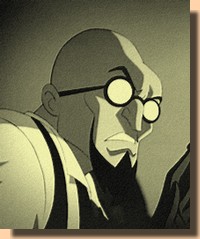 |
|
IDENTITY -
Hugo Strange, M.D., Professor of
Psychiatry FIRST
APPEARANCE -
Detective
Comics #36
(February 1940)
CREATED BY -
Bill Finger & Bob Kane
A classic "mad
scientist", Professor Hugo Strange
is one of Batman's first recurring and
long standing villains. A master criminal
who has a genius-level intellect and is
especially well versed in chemistry and
biology as well as psychology, he also
has a vast knowledge of fringe sciences
plus physical self-control techniques
such as yoga.
|
|
|
| |
"AS ALWAYS, YOU UNDERESTIMATE
THE VAST SCOPE OF MY SCHEMES, BATMAN !
EVIL TO ME IS AN END IN ITSELF !
NO ONE CAN EVER BE SAFE WHILE I YET LIVE !! "
Detective Comics #471
(August 1977)
|
| |
ORIGIN
Professor
Hugo Strange's exact background remains
shrouded in mystery - or, as Bruce Wayne
puts it in Detective Comics #36 (February 1940),
recounting Strange's first appeareance:
"Professor
Hugo Strange. The most dangerous man
in the world! Scientist, philosopher
and a criminal genius ... little is
known of him, yet this man is
undoubtedly the greatest organizer of
crime in the world..."
Presented as
a Professor, it was initially not
specified what subject and at which
university Strange had taught; he was
revealed to be a physician in Detective
Comics #471 (August 1977), and his
professorship was later (in the post
infinite crisis continuity) specified to
be in the field of psychiatry.
However, in
his first clash with Batman (written by
Bill Finger) Professor Hugo Strange is
portrayed as a criminal mastermind whose
genius lies in organizing and directing
criminal activities more than any
academic field. As such, he has also from
time to time been likened to being
Batman's very own “Professor
Moriarty”.
Unlike most
Batman villains of the early issues of Detective
Comics, Strange survived the first
encounter, giving him the opportunity to
announce both his will to escape and
return as well as his thirst for revenge
(a motif and vignette repeated several
times thereafter, not the least at the
end of the Joker's first appearance in Batman
#1).
APPEARANCES
Professor
Hugo Strange was indeed back very soon,
in Batman #1 (Spring 1940) -
escaping from prison where he had been
sent to in Detective Comics #36. Accentuating the
evil personality of Strange rather than
his criminal instincts, Bill Finger now
had him abduct homeless people and mental
patients who were then turned into
mutations - so called "monster
men": 15ft tall mindless brutes. To
achieve this hideous result, Strange
administered a powerful artificial growth
hormone that acts on the pituitary gland.
Wearing bulletproof clothing, the monster
men are sent out by Strange to spread
terror and chaos in the city whilst his
hoodlums are free to commit robberies.
|
|
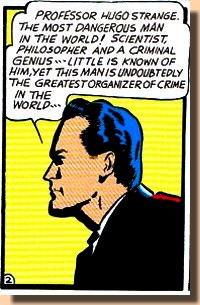
Detective Comics #36
(February 1940)
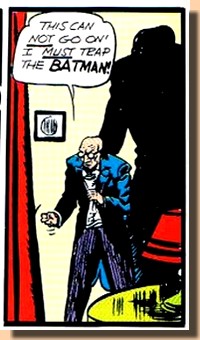
|
|
|
| |
| Again, Hugo Strange's
expertise and ruthlessness in biochemical engineering is
only a tool to achieve his goal, which is to satisfy his
financial greed. |
| |
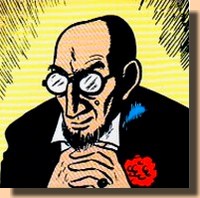 |
|
He
does, however, also nurture a desire to
inflict revenge on the one who brought
down his first criminal schemes, and when
the opprtunity arises Strange attempts to
turn Batman into one of his monster men;
however, during the ensuing struggle with
the Darknight Detective the Professor
falls through a window and into the deep
waters below his laboratory. As no body
is found, the Batman is doubtful that
this will be the last of Professor Hugo
Strange. And rightly so: the
evil mastermind returned that same year
(1940) for the December cover date
production run, in Detective Comics #46. Once again scripted
by Bill Finger, this third and at the
same time final appearance for the Golden
Age saw Strange's ambitions considerably
amplified as he now seeks nothing less
than to become the Dictator of America.
|
|
|
| |
| In order to achieve this
goal, Professor Hugo Strange has invented a “fear
dust” which provokes a sensation of immense terror
and fright in its victims (as a sidenote, this fiendish
weapon was devised several months prior to the first
appearance of the Scarecrow and his fear tactics). Strange has
his men spread the dust all over the city with the use of
spray guns, and he speaks of ultimately spraying it all
over the country so that none of the existing authorities
will have the courage to resist him. But again Strange's
plans are foiled by the Batman, and in a final struggle
on the edge of a cliff - in true Holmes and Moriarty
manner - the two antipodes clash. However, unlike the
great detective, it is only the villain who takes the
fatal fall, and this time the Batman is certain that the
Professor has met his final fate. |
| |
Professor
Hugo Strange was thus taken to be
well and truly dead, and he would
indeed become absent from the
Batman Universe for no less than
37 years of real time before
writer Steve Englehart and artist
Marshall Rogers had him return as
of Detective Comics #471
(August 1977) for the story arc
"Strange Apparitions"
which ran up until Detective
Comics #476 (March/April
1978) - and taps directly into
the 1940s material and
continuity.
Believed by
all to be dead, Hugo Strange did
in fact survive the fall. After
fleeing to Europe he soon took up
his criminal activities again,
but this time with great success,
made possible also by the fact
that there was no Batman to
contend with. It is, however,
precisely this fact which also
breeds a growing discontent in
Hugo Strange, and ultimately
makes him feel that there can be
only one challenge truly worthy
of the genius of Professor Hugo
Strange: to take on and bring
down the Batman.
Strange thus
returns to Gotham disguised as
one Doctor Todhunter and opens up
a clinic for the wealthy citizens
of Gotham City who suffer certain
all kinds of factual and imagined
ailments, and his private
institution soon becomes a trendy
go-to health place for Gotham's
bored socialites and VIPs.
However, once inside Graytowers -
as the clinic is called - Hugo
Strange first injects his
patients with his Monster Men
serum and then offers them shots
of a temporary antidote only and
as long as they obey his orders.
|
|
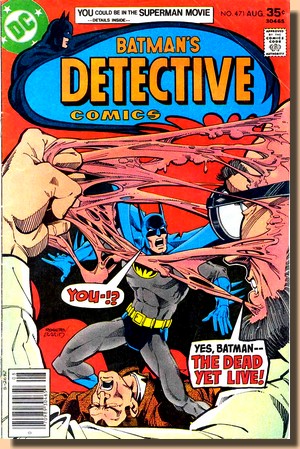
Detective
Comics #471
(August 1977)
|
|
|
|
| |
| Suffering from radiation
burns which Batman received whilst fighting Dr
Phosphorous in Detective Comics #470, Bruce
Wayne decides to try this new exclusive clinic everybody
is talking about. However, having been drugged right
after being admitted Wayne quickly realizes that the
place is a trap. He switches to his Batman gear (which by
chance he carries with him in a briefcase which was not
taken from him) and pretends to have broken in.
Confronting Doctor Todhunter, the clinic's head reveals
himself to be none other than Professor Hugo Strange -
long supposed dead but obviously still alive and back to
his gruesome experiments. |
| |
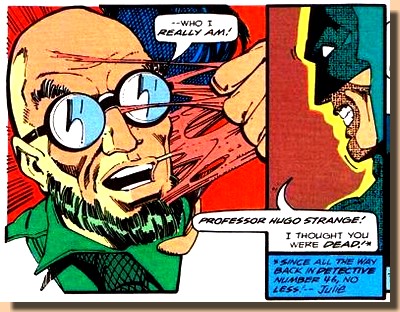
Detective
Comics #471 (August 1977)
|
|
Subdued once
again by drugs, the Batman finds
upon awakening that he has been
unmasked by Strange, who thus now
knows that Batman and Bruce Wayne
are one and the same. 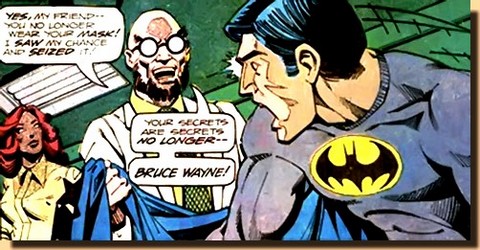
|
|
|
|
| |
| Strange, who has become a
master of disguises, immediately acts to gain the maximum
profit of his prisoner and his fortunate luck of the
moment by posing as Bruce Wayne and essentially running
the business of his nemesis' alter ego into the ground,
unhindered after having also made Alfred his prisoner (Detective
Comics #472). It is at this stage that Strange
develops his personal obsession with the Batman into
seeing himself actually taking on the Darknight
Detective's identity. His plans, however, are brought
down by Silver St Cloud, Bruce Wayne's latest love
interest, who ultimately detects that something is wrong
and calls Dick Grayson without knowing his secret
identity. As Grayson her gives the impression that he
sees no concern for alarm, but as Robin he storms
Graytowers and frees Bruce Wayne and Alfred. |
| |
Meanwhile
Hugo Strange is about to add the
glorious finishing touch to his
revenge by auctioning off the
secret identity of the Batman in
a midnight bidding involving the
Joker, Penguin, and corrupt
politician and criminal Rupert
"Boss" Thorne. However,
the Professor's plans are upset
by the ruthlessness of Thorne who
has simply decided to grab
Strange after the first bid is
made, abscond him and then beat
him up until he reveals the
secret.
It is here
that Hugo Strange once again
voices his belief that he and the
Batman are two of a kind. He thus
refuses to give up the
vigilante's secret identity -
even regretting his plans to sell
it off - and is beaten by
Thorne's men until they pronounce
him dead.
|
|
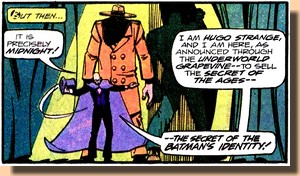
Detective
Comics #472
(September 1977)
|
|
|
|
| |
| Strange's motionless body
is encased inside a barrel and then tossed into the
Gotham harbour. Once again, it seems that Professor Hugo
Strange has finally met his fate. Whilst his next appearance, in Brave
and the Bold #182 (January 1982) took place outside
of the regular Batman continuity on "Earth-B", Professor Hugo
Strange gradually reappeared again five years after the "Strange Apparitions" arc, over a series of
issues of Detective Comics and Batman,
beginning with Detective Comics #513 (April 1982), during
which "Boss" Thorne is increasingly haunted by
what he feels to be - the ghost of Hugo Strange.
|
| |
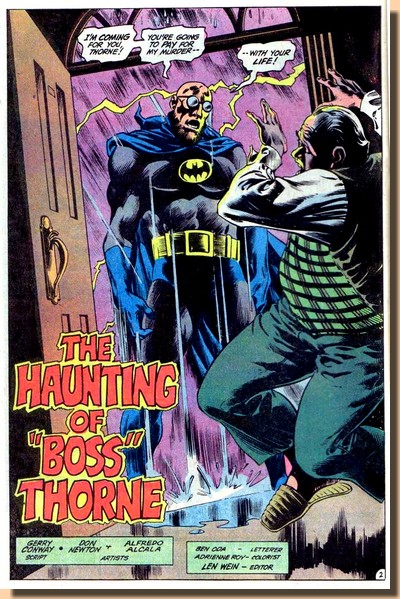
Detective Comics #520
(November 1977)
|
|
Thorne's
nerves are increasingly on edge and he is
starting to lose it when in Detective
Comics #520 (November 1982) he
finally decides to hire Terrence Thirteen
(a.k.a. “Doctor Thirteen, the
Ghostbreaker”) to investigate the
recent visions Thorne has had. Doctor Thirteen finds
sophisticated machinery in Strange's old
abandoned clinic Graytowers, used to
stage a spectacular special effects show
to impress Thorne. Which of course begs
the question who is behind all of this
technical trickery as surely it cannot be
Hugo Strange himself, known to be dead...
yet on the final page of Batman #354
(December 1982) it is revealed to the
readers only that, indeed once again,
Professor Hugo Strange is very much
alive, having survived the beating by
Thorne's men (as readers will soon learn)
through a certain yoga technique which
controlled his heartbeat...
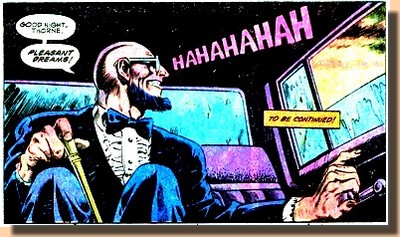
Batman #354
(December 1982)
|
|
|
| |
| Boss Thorne, unaware of the
fact that Hugo Strange is alive, believes his paid
partners in crime - Commissioner Pauling and Mayor Hill -
to be behind the ghostly apparitions in order to turn the
tables on him. Naturally,
the "Boss" is not someone to suffer such
disloyalty gladly, and so worked up that he accidentally
sets fire to his house, losing yet more of what he had
accumulated in power and wealth. |
| |
In a rage of
fury he seeks out Commissioner
Pauling and then shoots him point
blank in front of witnesses. In Batman
#355 (January 1983), "Boss"
Thorne is indicted with the
murder of Commissioner Pauling
and sent to
Blackgate Prison for life.
With his
revenge on Thorne complete, Hugo
Strange then once more turns to
his arch enemy, the Batman. Once
again his focus is on Bruce
Wayne, who in his eyes is
indebted to the Professor for
protecting the Batman's
secret alter ego (back
in Detective Comics
#472).
Again, Hugo
Strange seeks to destroy Wayne,
but this time (in Batman
#356, February 1983) he has a
much grander and bolder plan: to
become a new, more ruthless and
therefore more efficient Batman.
Strange succeeds in drugging and
kidnapping Wayne, taking him to
an intricate anbd exact replica
of Wayne Manor, complete with
Alfred and Dick Grayson - who
turn out to be murderous robots.
Wayne confronts a (for once)
clean shaven Hugo Strange in the
replica Batcave, where they both
change into bat costumes and then
fight it out - Batman versus
Batman. But once again, Batman -
with aa little help from the real
Robin - succeeds in upsetting and
bringing down the Professor's
plans. Beaten but unwilling to
give in and surrender, Hugo
Strange pulls a lever and blows
up both the replica Wayne Manor
and himself.
|
|
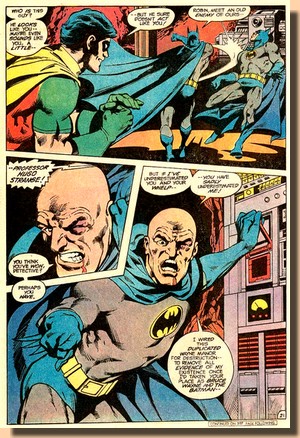
Batman
#356 (February 1983)
|
|
|
|
| |
| As before with Professor
Hugo Strange, death's grip was never firm enough to keep
him down - and return he did, in Batman Annual #10
(1986) at the hands of writer Doug Moench, penciller
Denys Cowan and inker Alfredo Alcala. Once again, Writer
had Hugo Strange once again impersonate Batman - although
this time he did so in order to blemish the vigilante's
reputation - and undermining Bruce Wayne's financial
standing as well as Batman's reputation. |
| |
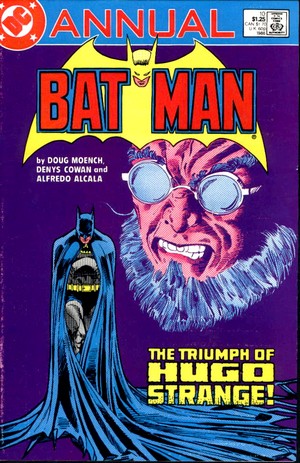
Batman
Annual #10 (1986)
|
|
Out of the
blue Bruce Wayne suddenly finds
his financial standing undermined
as large scale stock dealings
nearly ruin Wayne Enterprises and
drain his personal finances. At
the same time, Alfred suffers a
stroke and falls into a coma, and
if all of this wasn't enough
there is an impostor Batman on
the loose robbing Gotham's banks.
But that's just the start of
Bruce's misery as Lucius Fox is
forced to fire him, an anonymous
party purchases Wayne Manor and
has its former owner evicted, and
Gotham's child protective
services declare Wayne to be an
unfit guardian and strip him of
his custody for Jason Todd. Bruce Wayne
is homeless and broke, and Batman
now makes a belfry his home. And
the only answer which fits the
question who could be behind all
of this points to a man whom the
Darknight Detective thought was
finally dead. But who else other
than Professor Hugo Strange could
strip Batman "down to the
bone" (the title of the
story), being the only one who
knows the Batman's secret
identity and has the expertise in
posing as both Bruce Wayne and
his vigilante alter ego?
When
Batman, together with Robin
(Jason Todd), cracks down the
Batcave’s alarm and defense
system he is therefore anything
but surprised to find his old
arch enemy Hugo Strange there,
who explains that the fact that
he is alive is because the Hugo
Strange who blew himself up in Batman
#356 (February 1983) was actually
just one of his
"mandroids", i.e. a
near perfect robotic life model
decoy.
|
|
|
|
| |
| Bruce Wayne is able to
regain most of his fortune, Wayne Enterprises is saved,
and the batman can clear his name - and once again,
Professor Hugo Strange finds himself behind bars as it
all comes round in a full circle to his first appearance in 1940. |
| |
In the
"post-Crisis" DC
continuity Professor Hugo Strange
has been revisited several times
in separate story arcs, mostly
outside the regular Batman
and Detective Comics
titles.
In 1990/91,
Doug Moench revisited the theme
of Professor Hugo Strange being a
formidable enemy of the batman in
the vigilante's early and
formative phase of crime fighting
in the story arc
"Prey", which was
originally published in Legends
of the Dark Knight #11-15
and then collected for a trade
paperback. Strange is a
psychologist who is put on a task
force to hunt down this new and
mysterious vigilante and develops
an increasing fixation on the
Batman. He deduces the secret
identity of the Batman after
checking police files and on the
assumption that someone has
become the Batman because of a
childhood trauma which only the
simultaneous killing of both
parents could induce. He kindaps
the mayor's daughter in order to
put the blame on the Darknight
Detective and nearly does away
with the Batman by using
hallucinogen gas, but in the end
Hugo Strange is found out; trying
to escape in an imitation Batman
costume he is shot by the police
and falls into a river. A story
dotted with vignettes both from
the original Golden Age as well
as the Bronze Age stories, this
is basically a standalone
portrayal of Professor Hugo
Strange.
The mad
mastermind was back in Gotham
Knights #8 (October 2000) in
a four-part story arc (written by
Devin Grayson and pencilled by
Roger Robinson) entitled
"Transference" which
contains a number of references
to the "Prey" story
arc. The motif here, once again,
is Strange's obsession with
becoming and actually replacing
the Batman - a plan once again
foiled as Bruce Wayne, Robin and
Nightwing (who are once again
held hostage by Strange) don't
react the way he expects them to
from what he sees as the default
psychological perspective of the
Batman when subjected to stress.
This is enough to drive Hugo
Strange over the edge, but he
still manages to escape.
Even as the
"Transference" story
arc was still unfolding in Gotham
Knights, Doug Moench once
more revisited the evil professor
from January to May 2001 in Legends
of the Dark Knight #137-141
in a story arc entitled
"Terror". Again set in
the Batman's early stage of
crimefighting, the return of
Professor Hugo Strange takes
place in a shroud of mystery as
he decides to work with another
of Batman's enemies well versed
in "psychological
warfare": the Scarecrow. It becomes
apparent that Strange is even
more delusional about his own
identity and the Batman than
ever, enabling the Scarecrow -
who has realized that Strange is
only using him as a pawn in his
game against the Batman - to turn
against the professor, impaling
him on a weather vane and dumping
him in the cellar of his own
mansion. Trying to carry through
Strange's plan to use Crime Alley
as the scene of a psychological
trap for Batman the Scarecrow
fails because, of course, he is
unaware of the exact significance
of that location. Batman catches
Scarecrow in the cellar with
Strange's body before the house
is destroyed in a fire but loses
sight of Strange, although Batman
concludes that the subsequent
explosion of the house has
certainly killed Strange.
In 2005/2006
Matt Wagner revisited Hugo
Strange in his mini-series Batman
and The Monster Men which,
along with its sequel Batman
and the Mad Monk, was part of
Wagner's Dark Moon Rising
series in which he expanded and
modernized the early Batman
stories from the Golden Age.
EVOLUTION
OF THE CHARACTER
The mad
scientist is a stock character of
popular fiction (with Victor
Frankenstein being the archetypal
prototype) and typically embodies
the uncertainty whether science
will prove to be the salvation of
society - or its doom. The early
superhero genre in comic books
saw an especially large share of
mad scientists (partially due to
a substantial influence from pulp
fiction, which is where most
comic book publishers of the
1930s and1940s originally came
from), and these were most
prominently displayed and
characterized as "evil
geniuses" - such as Batman's
first ever traditional
supervillain and recurring
adversary back in 1939: Dr Karl
Helfern, who called himself Doctor Death.
Professor
Hugo Strange is arguably Batman's
best commonly known mad
scientist, and whilst he too
originated very early on in the
Batman's publication history,
Strange - unlike Doctor Death -
did not start out in life as
such.
In his first
appearance, it would seem more
likely for Hugo Strange to be a
Professor in Management or
Organizational Sciences; in Detective
Comics #36, he shows
himself to be a criminal
mastermind and planner who really
brings no science to his crimes
himself but coerces an engineer
to provide that input for him.
|
|
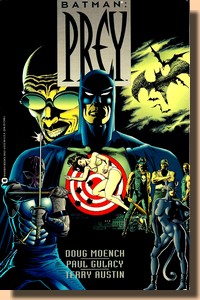
Batman:
Prey (1991)
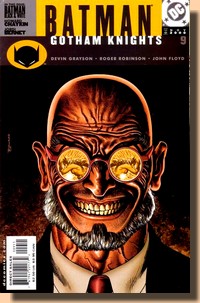
Gotham
Knights #9
(November 2000)
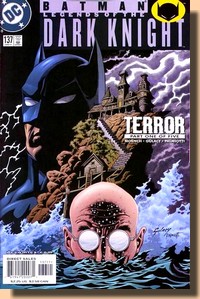
Legends
of the Dark Knight #137
(January 2001)
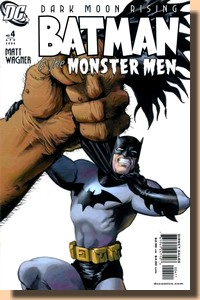
Batman
and the Monster Men #4 (April
2006)
|
|
|
|
| |
This is somewhat in contradiction to
his appearance, which bears all the traits of the
teutonic or Middle-European scientist who indulges in
highly questionable and unethical research and activities
- fuelled at the time by an increasing quantity of
disturbing information reaching the American public about
the pseudo-scientific attitudes and activities propagated
by the Nazi regime. Hence, both Doctor Death (Karl
Helfern) and (Hugo) Strange carry German names to
underscore their menacing personalities - superficially
hidden in both examples under the perfect outward attire
of a fine suit and cloak, albeit virtually betrayed by
the physical features of a bald skull, thick glasses and
a black beard or goatee.
|
| |
 |
| |
| It was only in his second
appearance, in Batman #1, that Professor Hugo Strange went
from just being an extremely resourceful man and
brilliant criminal strategist to becoming a true mad
scientist (see panels above). |
| |
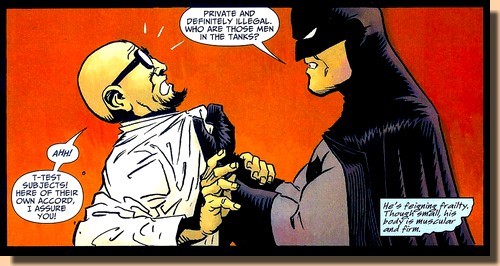
Batman and The Monster
Men (2005/2006)
|
|
Typically for the character
mould, it is the use of fictional science which
not only signals both insanity and danger but
also presents the terrible threat towards society
- in this case the dabbling in what would today
be termed genetical engineering and the resulting
creation of "monster men", bringing
Professor Hugo Strange very close indeed to his
prototype, Victor Frankenstein.
But
there is one aspect which makes Hugo Strange a
very unique mad scientist: his growing interest
in the Batman, which turns into a fixation and
ultimately a near-schizophrenic obession.
|
|
| |
| Strange not only wants to
become the Batman but actually feels he is the
real, the true Batman. And even though the Bronze Age
Hugo Strange is thus bent on doing away the original
vigilante and repalcing him, he is at the same time
highly dependant on the Batman's existence. Just as there
can be no Joker without a Batman, Hugo Strange's life
would be an empty shell without the Darknight Detective. |
| |
And this also
means that Strange cannot allow
anybody else to bring down the
Batman other than himself - which
is why he ultimately even
protects the secret identity of
his foe.
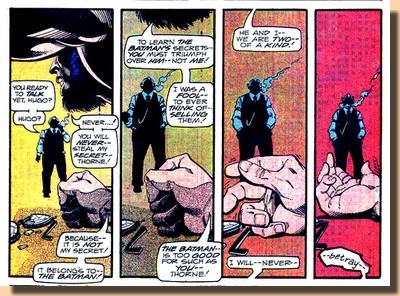
"He
and I", a struck down
Hugo Strange declares, "we
are two of a kind".
|
|
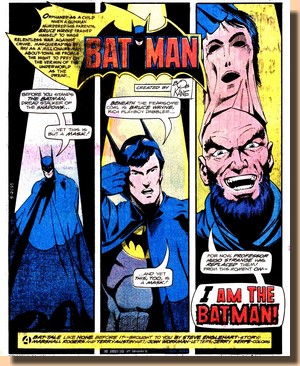
Detective Comics #472
(September 1977)
|
|
|
|
| |
| Another special trait is the
resourcefulness of Hugo Strange, which is especially
highlighted throughout his Bronze Age and later
appearances. Not only does he learn the Batman's secret
identity, he is also capable of convincingly faking his
death more than once. And that is just as well, for
Professor Hugo Strange is one of not too many Batman
villains who were there when it all started back in the
Golden Age and who are still "featurable" 75
years into the Batman mythos. |
| |
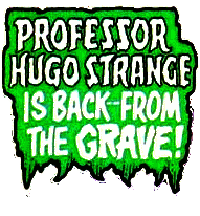 |
|
Maybe not
surprisingly, when Bruce Timm produced an
animation short in celebration of 75
years of Batman he thus chose Hugo
Strange as the villain. 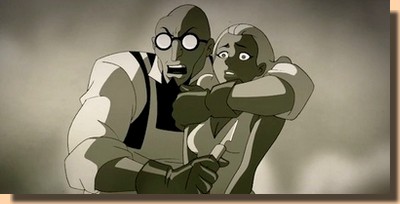
|
|
|
| |
| |
BATMAN and all
related elements are the property of DC
Comics, Inc. TM and © DC Comics, Inc.,
a subsidiary of Time Warner Inc.
The
illustrations presented here are copyright
material. Their reproduction for the review
and research purposes of this website is
considered fair use as set out by the
Copyright Act of 1976, 17
U.S.C. par. 107.
|
|

























